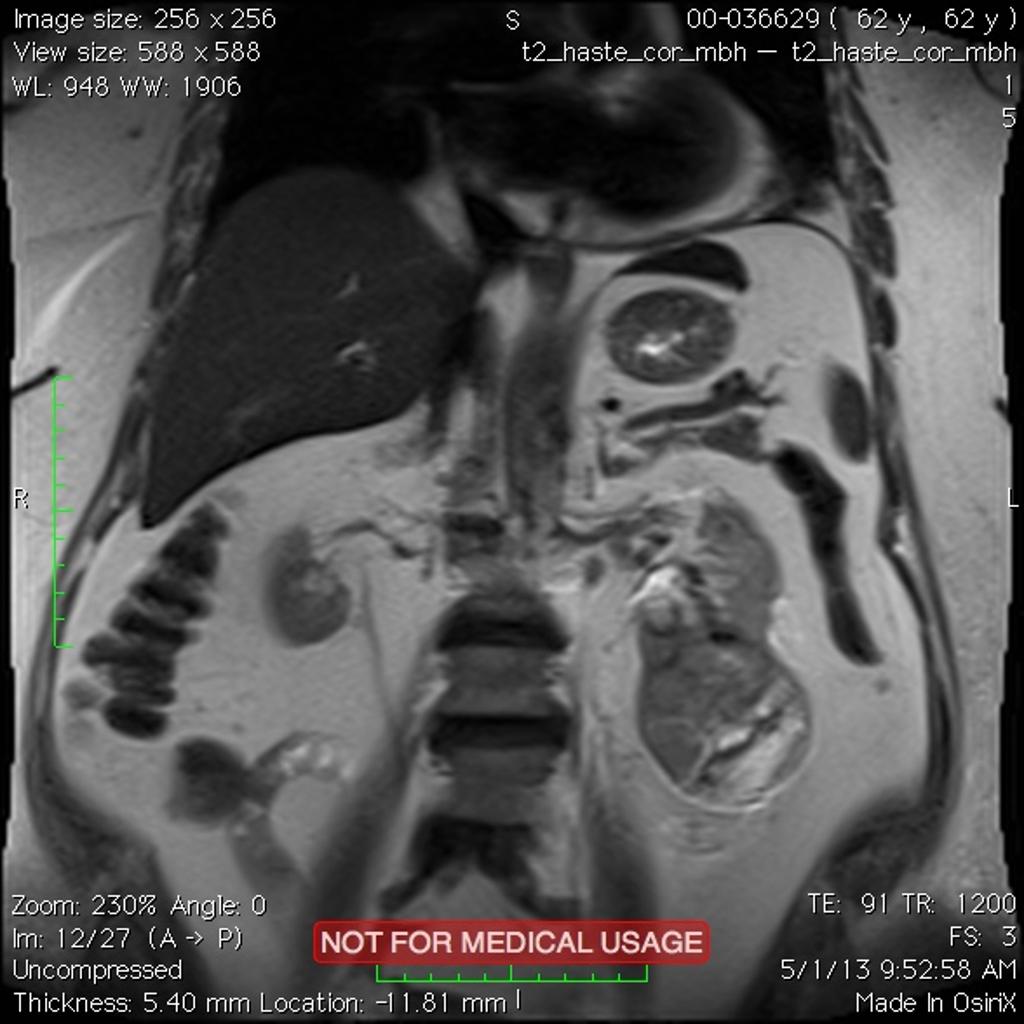Renal cell carcinoma MRI
|
Renal cell carcinoma Microchapters |
|
Diagnosis |
|---|
|
Treatment |
|
Case Studies |
|
Renal cell carcinoma MRI On the Web |
|
American Roentgen Ray Society Images of Renal cell carcinoma MRI |
|
Risk calculators and risk factors for Renal cell carcinoma MRI |
Editor-In-Chief: C. Michael Gibson, M.S., M.D. [1] Associate Editor(s)-in-Chief: Farima Kahe M.D. [2]
Overview
Renal MRI may be helpful in the diagnosis of renal cell carcinoma. Due to the use of IV gadolinium in MRI, the risk of nephrogenic systemic fibrosis (NSF) must always be considered.
MRI
Renal MRI may be helpful in the diagnosis of renal cell carcinoma. Due to the use of IV gadolinium in MRI, the risk of nephrogenic systemic fibrosis (NSF) must always be considered. It is a rare condition and often has cutaneous manifestations, but may affect any organ. Risk factors for development of NSF include:.[1][2][3]
- High dose of gadolinium-based contrast
- Acute and chronic renal failure
- Vascular injury
| Patient Profile | Use of MRI | Evidence Strength |
| Low Risk Patient (pT1, N0, Nx) | Baseline abdominal MRI (or CT) for nephron sparing surgery and CT (or US or MRI) for radical nephrectomy within 3-12 months following renal surgery Additional MRI (or US or CT) may be performed in patients following radical nephrectomy if initial post-op baseline image is negative |
Expert opinion C |
| Moderate to High Risk Patients (pT2-4N0 Nx or any stage N+) | Baseline chest and abdominal MRI (or CT) within 3-6 months following surgery with continued imaging (US, CXR, CT, or MRI) every 6 months for at least 3 years and annually thereafter to 5 years. Site specific imaging is warranted by clinical symptoms suggestive of recurrence or metastatic spread. Imaging (US, CXR, CT, or MRI) beyond 5 years may be performed at the discretion of the clinician | C |
| Active surveillance | Cross-sectional abdominal scanning (CT or MRI) within 6 months of active surveillance initiation to establish a growth rate. Further imaging is recommended at least annually thereafter | C |
| Ablation | Patients undergo cross-sectional CT or MRI with and without IV contrast unless contraindicated at 3 and 6 months following ablative therapy to assess treatment success. Annual abdominal CT or MRI should follow for 5 years. Individual MRI (or CT) beyond 5 years is based on individual patient risk factors | C |


References
- ↑ 1.0 1.1 Donat SM, Diaz M, Bishoff JT, Coleman JA, Dahm P, Derweesh IH; et al. (2013). "Follow-up for Clinically Localized Renal Neoplasms: AUA Guideline". J Urol. 190 (2): 407–16. doi:10.1016/j.juro.2013.04.121. PMID 23665399.
- ↑ Sankineni S, Brown A, Cieciera M, Choyke PL, Turkbey B (March 2016). "Imaging of renal cell carcinoma". Urol. Oncol. 34 (3): 147–55. doi:10.1016/j.urolonc.2015.05.020. PMID 26094171.
- ↑ Ravaud, Alain; Motzer, Robert J.; Pandha, Hardev S.; George, Daniel J.; Pantuck, Allan J.; Patel, Anup; Chang, Yen-Hwa; Escudier, Bernard; Donskov, Frede; Magheli, Ahmed; Carteni, Giacomo; Laguerre, Brigitte; Tomczak, Piotr; Breza, Jan; Gerletti, Paola; Lechuga, Mariajose; Lin, Xun; Martini, Jean-Francois; Ramaswamy, Krishnan; Casey, Michelle; Staehler, Michael; Patard, Jean-Jacques (2016). "Adjuvant Sunitinib in High-Risk Renal-Cell Carcinoma after Nephrectomy". New England Journal of Medicine. 375 (23): 2246–2254. doi:10.1056/NEJMoa1611406. ISSN 0028-4793.